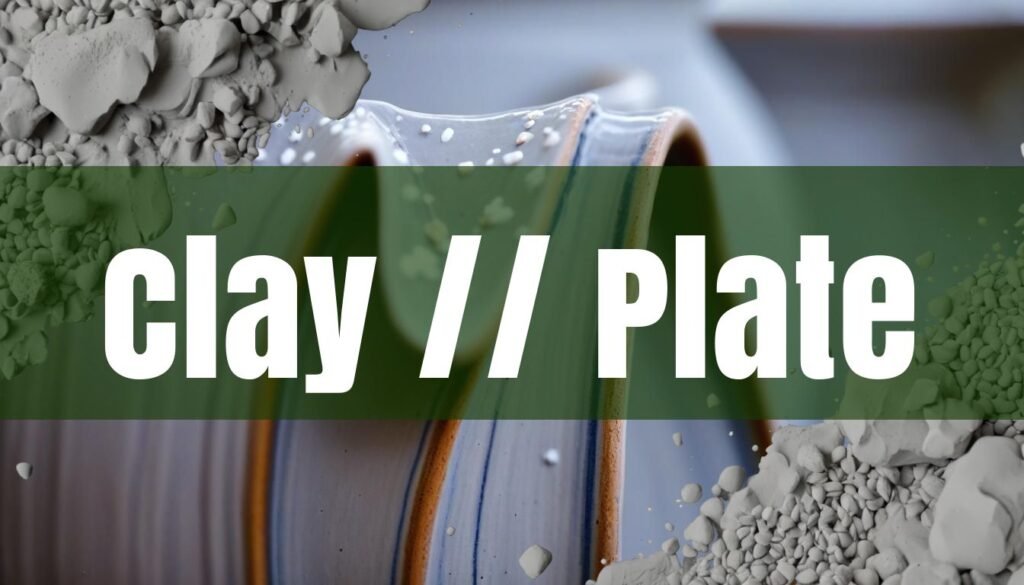Crafting your own clay plate is a rewarding experience, connecting you to an ancient art form while allowing for personal expression. Whether you’re a beginner or an experienced ceramicist, this guide will walk you through the essential steps to create a beautiful and functional clay plate. From selecting the right clay to applying the final glaze, we’ll cover everything you need to know.
Materials and Tools for Plate Making
Before you begin, gather your materials and tools. The type of clay you choose will significantly impact the final product’s durability, firing temperature, and food safety. Stoneware clay is often recommended for beginners due to its versatility and ease of use. It’s durable, strong, and non-porous when fired, making it suitable for holding liquids even without glazing. Earthenware clay, like terracotta, is another option, known for its rich red color, but it requires glazing to be waterproof. Porcelain clay, prized for its whiteness and translucency, is more challenging to work with but yields stunning results. No matter what you choose, ensure it works for you and the project you wish to make.
Essential tools include:
- Wedging table or surface: For preparing the clay by removing air bubbles and creating a uniform consistency (more on preparing clay).
- Rolling pin and slab pads or rolling machine: Helpful for creating slabs of even thickness (rolling slabs).
- Cutting tools: Such as knives, needle tools, and wire cutters, for shaping and refining the plate (cutting tools).
- Smoothing tools: Like ribs (metal, plastic, or wood) and sponges, to create a smooth surface (smoothing tools).
- Banding wheel: A rotating platform for even decorating and glazing (banding wheels).
- Kiln: For firing the clay, transforming it into durable ceramic (kilns).
- Food-safe glazes: To ensure the plate is safe for serving food (food safe glazes).
Techniques for Shaping Clay Plates
There are several methods for shaping clay plates, each offering unique advantages and aesthetic possibilities. Here, we’ll explore three popular techniques: the pinch pot method, the coil method, and the slab method. Experiment with all of them and find which one works for you. For a deeper dive, explore mastering hand-building pottery, which covers the pinch, coil, and slab methods in detail.
Pinch Pot Method:
The pinch pot method is one of the simplest and most direct ways to create a clay form. Start with a ball of clay that fits comfortably in your hand. Gently press your thumb into the center of the ball, creating a depression. Then, pinch the clay between your thumb and fingers, rotating the ball as you go, gradually thinning and raising the walls. This method is excellent for small plates or dishes, allowing you to feel the clay transform in your hands. While it may be challenging to achieve a perfectly even thickness, the organic, hand-formed quality is part of its charm. Consider trying this one first if you’re new to making plates.
Coil Method:
The coil method involves rolling out long, snake-like coils of clay and layering them on top of each other to build the plate’s walls. Score and slip the edges of each coil before attaching it to the previous one to ensure a strong bond. This technique allows for greater control over the shape and size of the plate. You can create intricate designs by varying the thickness and placement of the coils. After building the walls, smooth the interior and exterior surfaces with a rib or your fingers to create a seamless form.
Slab Method:
The slab method is ideal for creating plates with a flat, even surface. Roll out a slab of clay to your desired thickness using a rolling pin or a slab roller. You can use templates to cut out the desired shape or create freeform designs. To prevent warping, ensure the slab is evenly compressed and dried slowly. Once the slab is cut, you can add a rim by attaching coils or strips of clay to the edge. This method is particularly well-suited for creating sets of plates with consistent dimensions.
Drying, Firing, and Glazing
Once your plate is shaped, proper drying and firing are crucial to prevent cracking and warping. Dry the plate slowly and evenly, ideally under plastic, away from drafts of wind. This allows the clay to shrink gradually and reduces stress. Placing a weight, like a sandbag, on top can also help prevent warping. All these small steps help avoid issues in the long run.
Bisque Firing:
The first firing, known as bisque firing, hardens the clay and makes it easier to handle for glazing. Follow a firing schedule appropriate for your clay type, typically around cone 06-04 for earthenware and cone 6-10 for stoneware. Ensure you know the type of clay you’re using and what firing schedule is appropriate.
Glazing:
Glazing adds color, texture, and, most importantly, creates a food-safe surface. Choose a food-safe glaze and apply it evenly, following the manufacturer’s instructions. For surfaces that will come into contact with food, use a transparent or white liner glaze that you know does not contain harmful elements. For more inspiration, check out glazing techniques for potters and experiment with different colors and textures.
Glaze Firing:
The final glaze firing vitrifies the glaze, creating a durable, waterproof surface. Again, follow a firing schedule appropriate for your glaze, being mindful of potential issues like crazing (cracks in the glaze) or warping. If crazing occurs, a glossy, clear food-safe liner glaze can be added over the food surfaces.
Troubleshooting and Tips
Cracking during drying or firing is a common issue. Ensure even thickness in your clay slab and dry the plate slowly and evenly, as uneven drying is a primary cause of cracks. Warping can be minimized by drying the plate under weight and firing it on its side during bisque firing. Glaze imperfections can often be avoided by applying the glaze evenly and following the manufacturer’s recommendations for firing temperatures. It is crucial to be aware of these potential issues and how to troubleshoot them.
Creating clay plates is a journey of experimentation and learning. Embrace the process, celebrate your successes, and learn from any wobbles along the way. With practice and patience, you’ll be crafting beautiful, functional plates that reflect your unique artistic vision. Good luck, and have fun!





